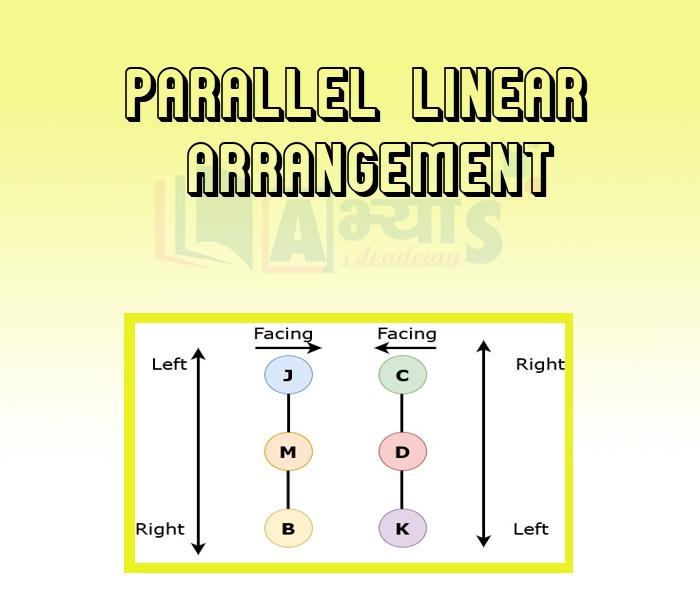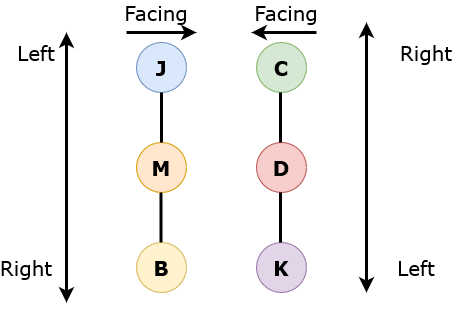Parallel Linear Arrangement








Parallel Linear Arrangement
Seating Arrangement: The seating arrangement is the logical arrangement of either objects or people in a specified order. One has to draw a diagram to analyse the arrangement then decode the relation between the position of the object.
Parallel Linear Arrangement: In this arrangement the objects or persons are made to stand in two rows parallel to each other. In the two rows either they are facing each other of they are facing in the same direction.The facing will decide the left and right position of each person.
Illustration: Study the following information carefully and answer the questions.
Question : - Which of the following groups represent the children standing in the same row ?
A. BDC B.BMD C. MJK D. None of these
Answer: D
Solution: We will start from M as M is not and the end of any row so M is in the middle of a row
and M is just to the right of J,
J is facing C.
Then K is just to the left of D, but D is facing M so we will first place D and then K.
We will then place B in the position which is vacant
So the diagram will be

From the figure it is clear that J,M,B are in one row and C,D,K in the second.So option A, B, C are incorrect
Hence the right option is D
Twelve people are sitting in two parallel rows containing six people each such that they are equidistant from each other. In row 1, Anika, Bianca, Catlyn, Dhruv, Esha and Feroj are sitting facing South. In row 2, Parul, Qadir, Rudra, Saumya, Tanuj and Vikram are sitting facing North. Therefore, in the given seating arrangement, each member sitting in a row faces another member of the other row.
How many persons are sitting between Esha and Feroj? | |||
| Right Option : C | |||
| View Explanation | |||
Twelve people are sitting in two parallel rows containing six people each such that they are equidistant from each other. In row 1: P, Q, R, S, T and V are seated and all of them are facing South. In row 2: A, B, C, D, E and F are seated and all of them are facing North. Therefore, in the given seating arrangement, each member seated in a row faces another member of the row.
How many persons are seated between V and R? | |||
| Right Option : B | |||
| View Explanation | |||
Study the following information carefully and answer the questions. (i) Six children B, D, C, M, J and K are split into two groups of three each and are made to stand in two rows in such a way that a child in one row is exactly facing a child in the other row. (ii) M is not at the ends of any row and is just to the right of J, who is facing C. K is just to the left of D, who is facing M. Question : - Who is to the immediate left of B ? | |||
| Right Option : A | |||
| View Explanation | |||
Students / Parents Reviews [10]
It was a good experience with Abhyas Academy. I even faced problems in starting but slowly and steadily overcomed. Especially reasoning classes helped me a lot.

Cheshta
10thMy experience was very good with Abhyas academy. I am studying here from 6th class and I am satisfied by its results in my life. I improved a lot here ahead of school syllabus.

Ayan Ghosh
8thI have spent a wonderful time in Abhyas academy. It has made my reasoning more apt, English more stronger and Maths an interesting subject for me. It has given me a habbit of self studying

Yatharthi Sharma
10thIt has a great methodology. Students here can get analysis to their test quickly.We can learn easily through PPTs and the testing methods are good. We know that where we have to practice

Barkha Arora
10thA marvelous experience with Abhyas. I am glad to share that my ward has achieved more than enough at the Ambala ABHYAS centre. Years have passed on and more and more he has gained. May the centre flourish and develop day by day by the grace of God.

Archit Segal
7thBeing a parent, I saw my daughter improvement in her studies by seeing a good result in all day to day compititive exam TMO, NSO, IEO etc and as well as studies. I have got a fruitful result from my daughter.

Prisha Gupta
8thMy experience with Abhyas is very good. I have learnt many things here like vedic maths and reasoning also. Teachers here first take our doubts and then there are assignments to verify our weak points.

Shivam Rana
7thAbout Abhyas metholodology the teachers are very nice and hardworking toward students.The Centre Head Mrs Anu Sethi is also a brilliant teacher.Abhyas has taught me how to overcome problems and has always taken my doubts and suppoeted me.

Shreya Shrivastava
8thAbhyas is a complete education Institute. Here extreme care is taken by teacher with the help of regular exam. Extra classes also conducted by the institute, if the student is weak.

Om Umang
10thAbhyas Methodology is very good. It is based on according to student and each child manages accordingly to its properly. Methodology has improved the abilities of students to shine them in future.
